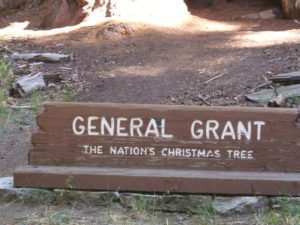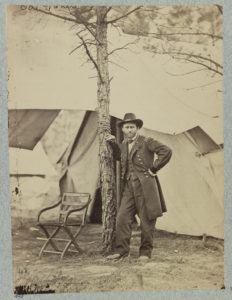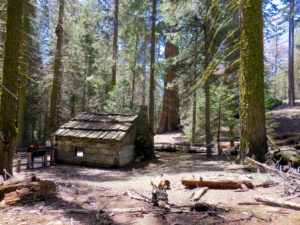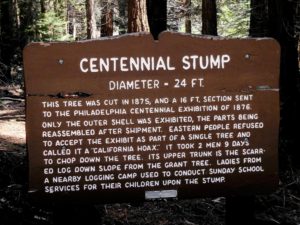What’s the story behind the second largest giant sequoia and the controversy with its naming myth?
By Sarah Elliott, 16 April 2019, 3RNews; editorial update 31 March 2021
There is no other tree on Earth that has had such attention and honor bestowed upon it by U.S. presidents than the General Grant Tree.
 The General Grant Tree is the second largest tree by volume in the world.* It is 268.1 feet in height, almost seven feet shy of the General Sherman Tree, the largest tree.
The General Grant Tree is the second largest tree by volume in the world.* It is 268.1 feet in height, almost seven feet shy of the General Sherman Tree, the largest tree.
Named for Ulysses S. Grant (1822-1885), the Union general and 18th president of the United States, it was designated as the Nation’s Christmas Tree by President Calvin Coolidge on April 28, 1926. The General Grant Tree is also a living memorial to the men and women of the United States who have given their lives in service to their country. It was proclaimed a National Shrine on March 29, 1956, by President Dwight D. Eisenhower.
Naming the Tree

The tree was purportedly discovered by Joseph Hardin Thomas in 1862. According to Park Service lore, it was reportedly named by Lucretia Baker of Visalia on Aug. 20, 1867, while General Ulysses S. Grant was still in command of the Union armies, however, there is some controversy in my family about who really named the tree.
My great-great-uncle, Hudson Barton (1844-1929), was once quoted as saying: “In 1866, one year before it is claimed that Mrs. Baker named the tree, I myself held a tapeline to my belt and walked around the General Grant Tree. I found it to be 106 feet in circumference. The tree was known as the General Grant Tree at that time. I further state that I was told by Joseph Hardin Thomas, owner of the sawmill in Shingle Flat [now Sequoia Lake] that he himself discovered and named the tree. Thomas made this statement in the presence of men who could have disputed it had they knowledge to the contrary.”
Mrs. Baker did send General Grant a frond from the tree, and Grant responded with a letter recognizing the honor.
Grant is well known for his victorious exploits in the Civil War. But at Shiloh (Tennessee) in April 1862, Grant fought one of the bloodiest battles in the West and came out less well.
For his next major objective, Grant maneuvered and fought skillfully to win Vicksburg, the key city on the Mississippi, and thus cut the Confederacy in two. By the end of 1862, he broke the Confederate hold on Chattanooga. Then, on December 17, 1863, Union General Ulysses S. Grant expelled all Jewish people from the Department of Tennessee, which included parts of Tennessee, Kentucky, and Mississippi, based on anti-Semitic stereotypes and rumors. He gave Jewish people just 24 hours to leave their homes, businesses, and lives behind. When Lincoln heard of the order, he was so shocked that he asked his staff for confirmation. Once they confirmed that it was real, he revoked it.
Annual Trek to the Tree
The first Christmas service at the base of the tree was inspired by the late Charles Lee of Sanger. In 1924, as he was gazing in awe at the huge tree, a small girl approached. “What a lovely Christmas Tree that would be,” she said, then turned and ran off.
The idea stayed with Lee and on Dec. 25, 1925, he organized the first Christmas program at the tree. Upon returning home, Lee wrote a letter to President Coolidge, who adopted Lee’s suggestion.
Christmas services have been held each year since, except during World War II when travel was restricted. The ceremony is sponsored by the Sanger Chamber of Commerce.
At the annual event, the National Park Service places a wreath at the base of the tree in honor of our fallen heroes.
Getting there
It is located just inside the Kings Canyon National Park entrance in the Grant Grove. Turn left off of Highway 180 one-quarter mile past Grant Grove Village. Travel 1.2 miles past Azalea Campground and Columbine Picnic Area. It is an easy, quarter-mile walk to the General Grant Tree from the parking lot, where also seen will be the Fallen Monarch, which has been historically used as both living quarters and a stable; the Gamlin Cabin, home to brothers Israel and Thomas Gamlin in the 1800s while they worked their 160-acre timber claim in the Grant Grove; and the Centennial Stump, all that’s left of a Big Tree that was cut down in 1875 for display at the World Exposition in Philadelphia.
*NOTE: The General Grant was not always deemed the second largest tree. The Washington Tree held that honor untl the summer of 2003.
2003 was a tough fire year. The Dinely Fire in Three Rivers, Calif., created many tense moments for homeowners. Antelope Mountain in Woodlake burned.
In Sequoia and Kings Canyon National Parks, fire crews were busy balancing prescribed fires and several lightning-caused blazes, including a particularly destructive one in the Giant Forest. Although orders were given to create a perimeter around the Washington Tree and protect it from the approaching fire, something went horribly wrong. Word slowly trickled out that the second largest tree in the world had caught fire.
The Washington Tree, located in a remote corner of the Giant Forest Grove, is these days a shell of itself; its defining branch, bigger than most mature trees, is on the ground in a charcoal heap. As of this writing, the Washington Tree has been removed from this list of the “Biggest of The Big Trees.” It no longer holds the distinction of #2.


